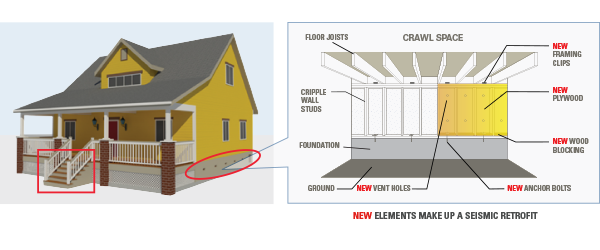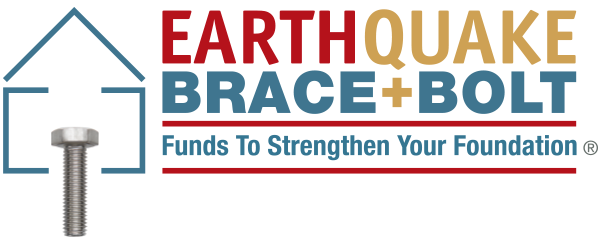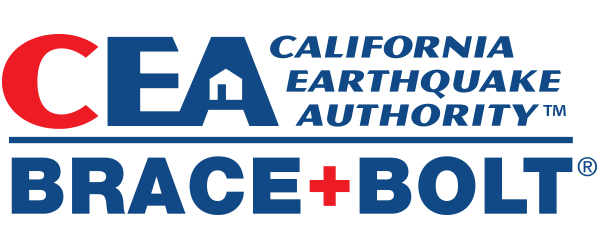Earthquakes occur suddenly and without warning. The motion on the earth's crust can cause severe damage to older homes. Homes built before 1980 are especially at risk because many were not built to resist shaking and moving.
Why Retrofit Your Home?
The purpose of seismic retrofits for earthquakes is to keep your home from being displaced from its foundation—making the building safer and less prone to major structural damage during an earthquake.
The 2014 South Napa earthquake occurred on August 24 at 03:20:44 Pacific Daylight Time. This 6.0 M severe event was the largest quake in the San Francisco Bay Area since the 1989 Loma Prieta earthquake.
Houses shook violently, but two houses that sit side-by-side in Napa had different outcomes. One stood undamaged, its neighbor had shifted off its foundation with dramatic structural damage.
Consider this case study on the cost effectiveness of retrofitting.
What Are the Chances of a Major California Earthquake?
California has more than a 99% chance of having one or more magnitude 6.7 or larger earthquakes within the next 30 years, according to scientists.
- For Northern California, the most likely source of such earthquakes is the Hayward-Rodgers Creek Fault (31% in the next 30 years). Such quakes can be deadly, as shown by the 1989 magnitude 6.9 Loma Prieta earthquake. The Loma Prieta quake caused 63 deaths, 3,757 injuries, and about $6 billion in damage.
- For Southern California, within the next 30 years the probability is 60% for an earthquake measuring magnitude 6.7. The southern San Andreas fault is much closer to Los Angeles, running at its closest just 25 miles northeast of downtown through the San Gabriel Mountains, and is capable of unleashing a magnitude 8.2 quake throughout all of Southern California. The 2019 Ridgecrest earthquake happened on a brand new fault line along the Eastern California Shear Zone.
The new study determined the probabilities that different parts of California—including higher-risk areas like the Bay Area and the city of Los Angeles—will experience earthquake ruptures of various magnitudes. The new statewide probabilities are the result of a model that comprehensively combines information from seismology, earthquake geology, and geodesy (measuring precise locations on the earth’s surface).
What are the Benefits of Retrofitting?
Earthquake retrofitting (seismically retrofitting) a house is done to prevent displacement from the structure’s concrete foundation. This makes a building safer and less likely to suffer damage during an earthquake.
Retrofitting single-family homes is considered one of the cheapest seismic improvements available. A foundation bolting process usually costs a few thousand dollars and can be done within several days without the residents moving out.
What is the Cost of Retrofitting?
While there isn’t a standard cost for earthquake retrofitting a home, the range is usually about $3,000 to $7,000. Larger homes, those built on hillsides, and those with basements or rooms over garages will typically cost more to retrofit. Many houses that require only bolting cost about $3,000.
Why Retrofitting is Necessary?
Reason 1: Increase safety
Properly retrofitted houses are made stronger against earthquake shaking and damage. This means your house is safer, and you’ve reduced the chance of injury or even death in a devastating earthquake.
Reason 2: Financially protect your investment
You have invested a lot of time and money into your older house. Without a seismic retrofit, the repair costs you’d face after a damaging earthquake could be very costly. Think of it this way: it’s a lot cheaper to retrofit your house now than it is to repair it after an earthquake.
Reason 3: Make sure you have a place to live
If you have not seismically retrofitted your house and an earthquake damages it, it could take years to repair, and you may have to take out a loan to make repairs. Also, keep in mind that people often have to move out of their home during repairs, and rental costs typically go up in affected areas following a major disaster. That means you could be paying repair costs, rental costs, and your mortgage—all at the same time!
How to Retrofit
All Californians should have their homes assessed to determine if they need to be retrofitted. As mentioned earlier, the 2019 Ridgecrest earthquake happened on an unknown fault and the 2014 Napa earthquake happened on an unexpected fault. The retrofit work of seismic upgrades will likely:
- Improve a home's ability to keep residents safe during an earthquake and the house habitable after a major disaster.
- Reduce repair costs after a seismic event.
- Reduce earthquake insurance premiums.
The goal of retrofitting is for homeowners to shelter in place and survive a major earthquake. Earthquake reinforcement will reduce damage to the structure and keep the home habitable.
Retrofitting will keep your house from being displaced from its foundation. The terms house bolting and foundation bolting are often used interchangeably with earthquake retrofitting.
Cripple Wall Bracing
Cripple walls are short walls that rest on a house’s foundation and support the floor and exterior walls. When these walls are not braced, they may shift during an earthquake. When this occurs, the chances of severe damage to your house and injury to individuals increases. Bracing cripple walls strengthens structures by increasing stability, and the process typically helps minimize damage to houses. See the image above to understand how new elements in the crawl space enhance the house's earthquake resistance.
Foundation Bolting
Houses that aren't bolted to their foundation can move during an earthquake. Houses that move off their foundation will cause significant damage and may be costly to repair. The bolting process requires that holes are drilled through the sill plate on a foundation and anchor bolts are installed. Sometimes, there isn't enough space to drill, and steel plates will also need to be attached. These bolts must be properly installed to be effective.
Reinforce or Strap Chimneys
Brick chimneys account for the most common damage during larger California quakes. When chimneys collapse, bricks can become deadly projectiles. At least 15,000 brick chimneys were damaged in Los Angeles during the 1994 Northridge earthquake. In Napa, about half of the residential buildings damaged were due to brick chimneys.
Our Chief Mitigation Officer, Janiele Maffei, says homeowners should ask themselves:
To keep bricks from falling through the roof during an earthquake, here are some reinforcement options:
- One option is to add layers of plywood on the roof around the chimney.
- Another is to remove the upper part of the chimney, which can twist and turn during shaking, and replace it with metal.
- A third option is to add a diagonal steel brace to the chimney.
Even with those improvements, the chimney still could collapse. In Los Angeles County a more extensive retrofit is required. It involves removing the chimney completely or rebuilding it.
If the homeowner doesn’t need the chimney to be functional, the retrofitting could be as simple as placing a steel tube down the structure and filling it with concrete.
Reinforce Masonry Walls
If your older home has poor wall anchorage, consult a certified engineer on the most cost-effective way to strengthen it. A qualified contractor can add new anchorage and continuous ties across the roof. Walls can also be strengthened between the connections between the roof and floor joists.
Soft Story Above the Garage
Many soft story homes have a story with a bedroom or playroom above attached garages. Such a room opening has little or no stiffness or shear strength. Such a story is “soft” in its resistance to lateral movement such as an earthquake.
Soft story conditions can sometimes be improved by installing new plywood sheathing or steel reinforcements on each side of the garage door. Some garage doors require a steel frame to be properly retrofitted for earthquakes, which can be done through an engineered retrofit.
Hillside House
Houses on steep hillsides are often set on tall, narrow posts or columns, with or without diagonal bracing, and may have walls that “step down” the hill and may not be properly braced to withstand earthquakes. Without seismic retrofitting these homes can suffer significant damage or even collapse during an earthquake.
Learn more about hillside houses.
Post and Pier House
A post-and-pier house is built on wooden posts or concrete piers set into the ground to bear the weight of the house, and is vulnerable during an earthquake to shifting, and potentially collapsing.
To withstand the effects of earthquakes, post-and-pier houses should receive a new continuous-perimeter foundation, with any cripple walls bolted and braced. Learn more about the retrofitting of a post and pier house.
Install Gas Shut-off Devices
Know how to turn off the gas or learn if you should have an automatic gas shut-off valve installed that is triggered by strong vibrations. Consult with your local gas company before doing any work.
From Red Tag to Green
Local, state and federal authorities use a color-tagged system--classified by a red-yellow-green color— to represent the severity of earthquake damage or the overall condition of a home or building. The red and yellow tags are an indicator of whether the home is habitable. Red tagged homes are deemed too dangerous to live in. With proper seismic retrofitting, the homes may receive a green tag.
Is Your House at Risk for Earthquake Damage?
Prepare your home BEFORE an earthquake. Decrease your risk of damage and injury from an earthquake by identifying possible structural risks and geologic hazards near you. Visit CEA’s faults by county map to get the facts about earthquake hazards near your home.
Consider earthquake insurance to protect the financial investment you have in your home. CEA policies provide you with the strength to rebuild and repair, funds to live elsewhere while repairs are being made to your home, and help replace your personal property if it is damaged in an earthquake.
Contact your insurance agent or residential insurance company to find the CEA policy that is right for you.
How to Protect Your Home before an Earthquake Strikes
An earthquake’s powerful shaking can rupture the earth, trigger landslides, and turn the surface of the earth to liquid. Your home also may be vulnerable to serious structural damage if it was built before 1980.
Get tips on how to prepare and protect your home against earthquake damage.
Understanding Structural Risks
Earthquake safety preparation requires your understanding of the potential structural threats to your home in case of an earthquake.
A seismic retrofit involves strengthening your home’s foundation to make it more resistant to shaking. CEA offers earthquake home insurance premium discounts for houses and mobilehomes that have been properly retrofitted.
Find out about seismic retrofit grants to help pay for retrofits under the Earthquake Brace & Bolt Program, and the CEA Brace & Bolt program.
Evaluating Geologic Hazards
With nearly 16,000 known state faults, most of us live within 30 miles of an active fault. All of California is earthquake country. It is not just Los Angeles, San Diego, and the San Francisco Bay Area that are home to active faults. Every region of the state holds a degree of earthquake risk.
Find out about faults in your area by visiting the CEA risk map for each county. This information will help you create an earthquake precaution checklist.
Then learn about your home’s structural risks and the steps you can take to seismically strengthen your house. California Office of Emergency Services MyHazards can help you find out if the area where you live or work is prone to earthquake-induced landslides.
Do I Need Earthquake Insurance?
Consider these facts in the event of a large earthquake:
- Earthquakes can cause extensive damage to the foundation, siding and roof of homes. Older homes built before 1980 on a raised foundation are especially vulnerable if they are not retrofitted.
- Without residential earthquake insurance you will be responsible for all repair and/or rebuilding costs.
- Government disaster assistance, if available, only comes in the form of a small grant or capped loan, which may cover only a portion of your repair costs.
- Without Loss of Use earthquake coverage—which includes covering additional expenses of living elsewhere—you’d still be paying your mortgage plus temporary housing rent during the time repairs are underway.
CEA affordable earthquake insurance policies let you select the coverage that fits your budget. Our insurance rates, based on the latest science and research, are determined by several factors including your home’s age, location near a fault, foundation type, construction type, and roof type.
Brace & Bolt Programs
If your home was built before 1980 it is more vulnerable to earthquake damage and collapse. Earthquake reinforcement or seismic retrofitting will strengthen your home against earthquake damage. Homeowners with properly retrofitted eligible houses can receive a CEA insurance premium discount of up to 25%.
We offer two programs to help eligible homeowners pay for their retrofits. Owners of hillside houses may be eligible for these programs if their house qualifies under California Existing Building Code Chapter A3.
- CEA Brace + Bolt (CEA BB) offers grants of up to $3,000 to current CEA policyholders for houses that qualify.
- Earthquake Brace + Bolt (EBB) offers grants of up to $3,000 to homeowners in certain higher-earthquake risk ZIP Codes for houses that qualify. (2022 Ed Note: the CEA BB program was retired in 2021 and is now closed.)
Get Earthquake Insurance Discounts
Find out about brace and bolt seismic retrofit grants to help pay for retrofits under the Earthquake Brace & Bolt Program, and the CEA Brace & Bolt program.
Whether or not you participate in a grant program, if you properly retrofit your eligible house (eligibility includes having been built before 1980 and of wood frame construction), you could receive a CEA insurance premium discount of up to 25%.
Get an Estimate (Calculator)
Consider earthquake insurance to protect the financial investment you have in your home. CEA policies provide you with the strength to rebuild and repair, funds to live elsewhere while repairs are being made to your home, and help replace your personal property if it is damaged in an earthquake.
Contact your insurance agent or residential insurance company to find the CEA policy that is right for you.





